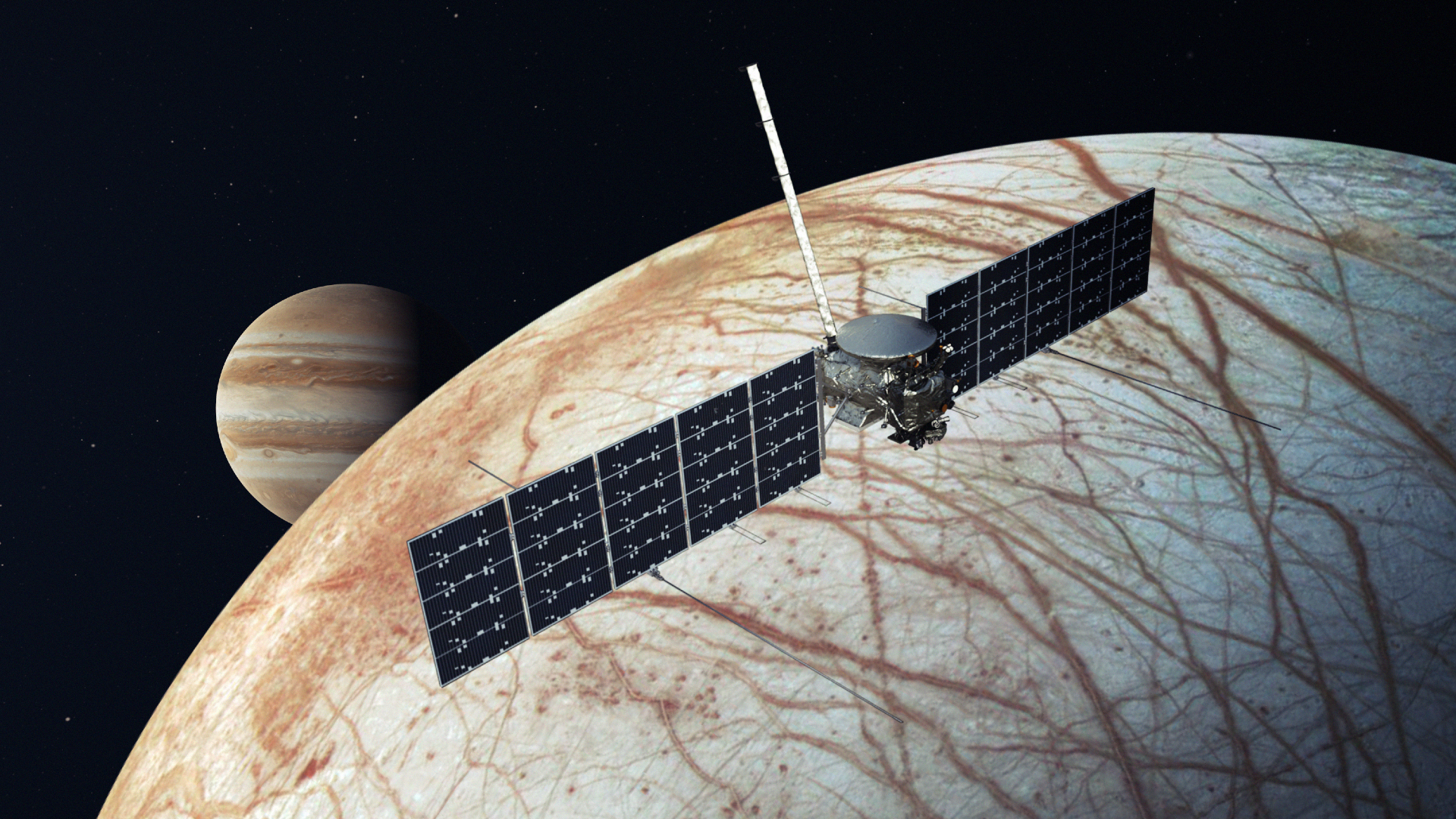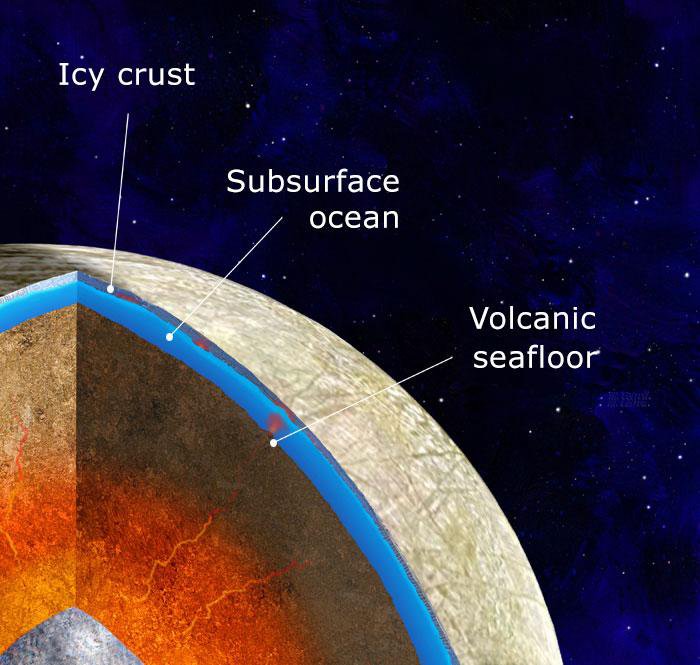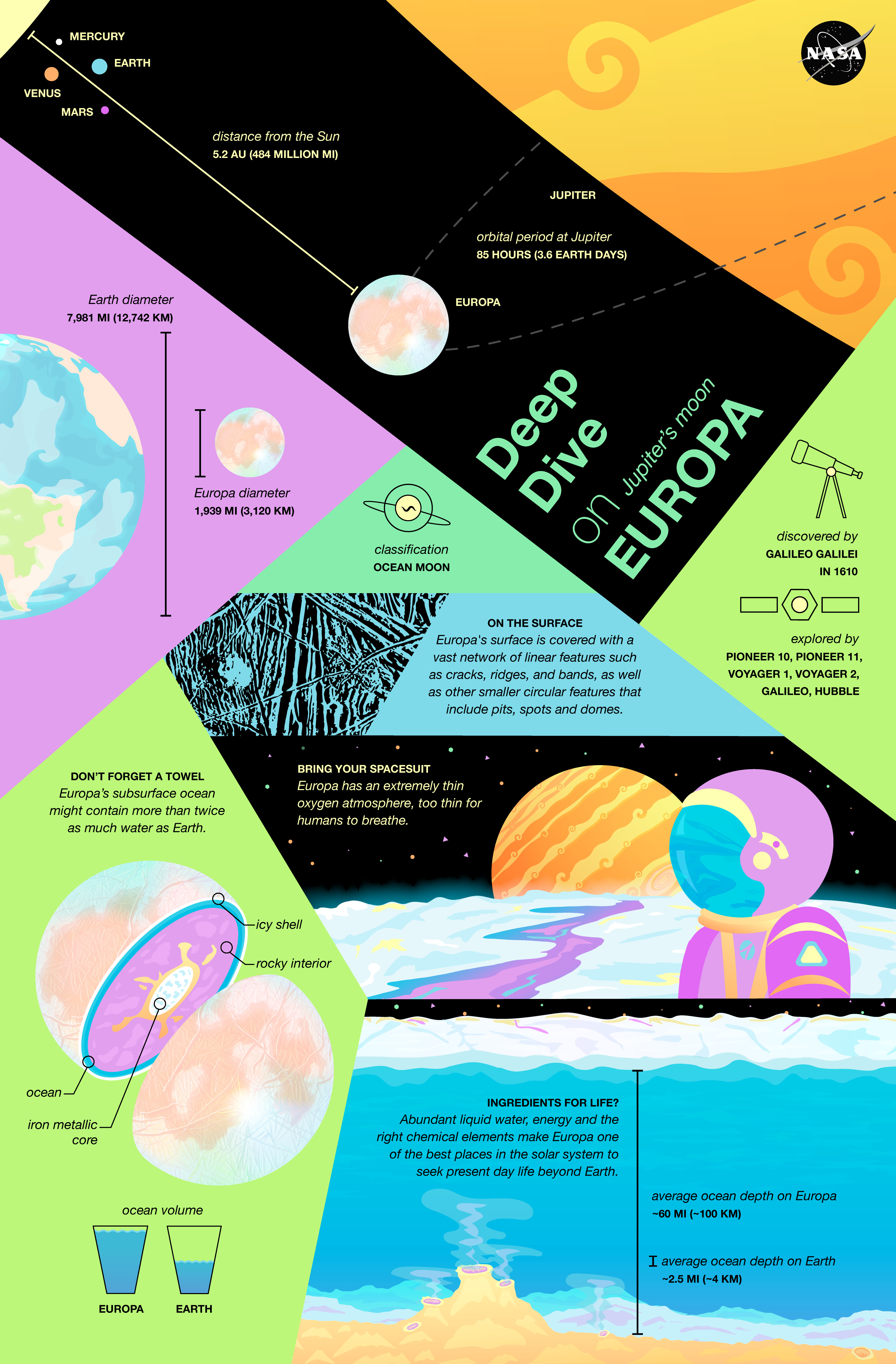Europa Clipper: A complete guide to NASA's astrobiology mission
The Europa Clipper mission will probe Jupiter's icy moon Europa.

Europa Clipper is NASA's mission to explore Jupiter's moon Europa and determine whether its underground ocean is habitable.
The mission launched on Oct. 14, 2024, atop a SpaceX Falcon Heavy rocket from NASA's Kennedy Space Center in Florida. It will take about five and a half years for Europa Clipper to reach the Jovian neighborhood.
To keep up to date with the latest mission developments check out our Europa Clipper live updates blog.
Discovered in 1610 by Italian astronomer Galileo Galilei, Europa is one of the most promising places in the solar system to search for life beyond Earth, scientists say.
Related: The 10 weirdest moons in the solar system
The $5 billion Europa Clipper spacecraft will first head toward Mars.
On Feb. 27, 2025, Europa Clipper will gain a gravitational assist from the Red Planet, stealing some of Mars' momentum to be slingshotted back toward Earth. On Dec. 1, 2026, the spacecraft will get an Earth gravity assist and be thrown on a high-speed trajectory towards Jupiter, NASA's Europa Clipper mission page explains. Orbital scientists call this a Mars-Earth gravity assist (MEGA) trajectory.
When will Europa Clipper arrive at Jupiter?
Europa Clipper will reach Jupiter on April 11, 2030, when it will enter a long, looping orbit around the gas giant planet, scientists explained in a paper published in the Journal of Guidance, Control, and Dynamics. The spacecraft will take a year to adjust its orbit around Jupiter, fine-tuning its trajectory to bring it close enough to Europa for the first of nearly 50 close flybys, according to the Laboratory for Atmospheric and Space Physics at the University of Colorado Boulder.
Europa Clipper will orbit Jupiter instead of Europa because of the danger of radiation. Jupiter has dozens of moons; the four largest are known as the Galilean moons. In order of their distance from Jupiter, they are the volcanic Io (which is so close that it is stretched and squeezed by Jupiter's massive gravitational grip), Europa, Ganymede and Callisto. NASA explains that, as the second large moon out from Jupiter, Europa is quite deep inside Jupiter's magnetosphere, the immense magnetic envelope generated by Jupiter's powerful magnetic field. Charged particles zip around the magnetosphere in the form of plasma, with enough energy to fry a spacecraft's electronics if it were to linger deep within the magnetosphere.
So Europa Clipper, like NASA's Juno mission before it, will adopt an elliptical orbit that takes it far out from Jupiter and the radiation for most of the orbit, before sailing in for a close approach of Europa and then back out, over and over again. This will allow the spacecraft to pass over a different part of the moon each time to survey the entire surface.
Why is the Europa Clipper going to Jupiter's neighborhood?

NASA is sending a spacecraft to investigate Europa because it is one of the most promising places in the solar system to hunt for extraterrestrial life. Several missions — including Pioneer 10 and 11, Voyager 1 and 2, Galileo, Juno, Cassini and New Horizons — have gathered strong evidence that Europa contains a huge ocean in its interior, beneath a shell of ice estimated to be between 2 to 20 miles (3 to 30 kilometers) thick according to NASA.
Astrobiologists wonder if where there is water, there could also be life. Europa Clipper will make at least 45 close flybys of the Jovian moon. From the spacecraft's vantage point high above Europa's surface, Europa Clipper should be able to find out whether the conditions in Europa's ocean are suitable for life as we know it.
Europa Clipper FAQs answered by an expert
We asked Marshall Styczinski, a NASA postdoctoral fellow working on Europa Clipper at the Jet Propulsion Laboratory in California, a few frequently asked questions about the mission.

Marshall Styczinski is a NASA postdoctoral fellow working on Europa Clipper at the Jet Propulsion Laboratory in California.
Why is Europa so important for planetary science?
We have strong evidence for a liquid water ocean there! Water is required by all known life, and the conditions in the ocean can tell us a lot about the history of Europa and why it looks the way it does, inside and out. Even better, Europa's ocean is likely in contact with the rocky seafloor. That means we expect chemical reactions that would create hydrothermal vents, like in Earth's oceans. Hydrothermal vents support thriving ecosystems on Earth, so they might be doing the same on Europa.
Intense radiation from Jupiter produces oxidants at the surface too. Oxidants are needed for microbes, like how a fire on Earth needs both a fuel source and oxygen to keep burning. Along with the gases produced in hydrothermal vents, there might be all that life needs to get started, grow and survive in Europa's ocean. Understanding how and where these activities might be going on within Europa will help us determine whether there might be life inside Europa and how we might apply the same techniques to other moons and planets.
What signs of habitability will Europa Clipper be looking for?
So many things! All of the investigations on board Europa Clipper are geared toward trying to better understand Europa, including whether the ocean is habitable. Other places, like melted parts of the ice shell, might be habitable too, and if we can find them, we'll study them too. My expertise is in magnetic fields and geophysics, so I'll speak to that.
We can constrain the properties of the ocean from combining measurements of the gravity field, magnetic field and ice-penetrating radar. Gravity helps us figure out how deep the seafloor is, the magnetic field relates to the amount and type of salts dissolved in the water, and radar can tell us the thickness of the ice shell during a flyby.
We need measurements from the other instruments to better understand which kinds of salts are likely to be found in the ocean. When we put everything together, we can infer what pressure, temperature and salt content the ocean exists under. Then, comparing to similar Earth environments allows us to understand the ocean's habitability. There's a lot involved in peering down through 20 miles [32 km] of ice to investigate the ocean!
How deep do we think Europa's ocean is?
The measurements we have from Galileo give a pretty wide range for the ocean depth and the ice shell thickness over it. Most estimates range from 31 to 93 miles [50 to 150 km] for the ocean depth and between 3 and 25 miles [5 and 40 km] for the ice shell thickness. These estimates are from interpretation of the gravity field, magnetic field and surface conditions of Europa. Some surface features — such as temperatures, crater shapes and terrain types — limit the thickness of the ice shell to be within a certain range. Geophysical models of how the ice shell changes over time are also important for interpreting the measurements.
How much radiation will the spacecraft be exposed to at Jupiter?
We have a guideline for how much radiation Europa Clipper is rated to withstand and still function well. Spacecraft have a different reaction to radiation than humans, so the numbers are a bit hard to relate to. In the current mission plan, we expect to receive about 3 megarads (Mrad) during a little less than 50 flybys. Europa Clipper is designed with radiation-hardened components that are well-prepared for the intense radiation. The mission is designed around an elliptical orbit around Jupiter that gives us plenty of time in low-radiation environments far away from the planet to send back the data we gather when we dip in close to fly by Europa.
Based on one of my favorite charts ever — the XKCD Radiation Chart — and my estimates of the radiation types the spacecraft will experience, in each flyby, Europa Clipper will withstand about six to 10 times the lethal dose for a human. This amount of radiation won't be a big deal for the spacecraft, though, because it's designed with a lot of redundancy in computing and built with tough components. We have a lot of great engineers on the project with experience designing for these environments!
All about the Europa Clipper spacecraft
Europa Clipper will be the largest spacecraft that NASA has ever launched to another planetary system. Most of Europa Clipper's large size comes from its solar panel array, which, when deployed, will span 100 feet (30 meters) — longer than a tennis court. It has to be this big because of Jupiter's distance from the sun; the giant planet is five times farther from the sun than Earth is, and the sun's rays are 25 times more feeble there compared with those that light up our planet, so more area is needed to gather enough sunlight to power the spacecraft. The bulk of the spacecraft, without the solar panels, is a more modest 16 feet (5 m) in height. Europa Clipper's "dry mass" — that is, its mass not including fuel — is 7,145 pounds (3,241 kilograms). At launch, with its tanks full of thruster fuel, Europa Clipper will be about 13,000 pounds (6,000 kg), according to NASA.
To protect against the hazardous radiation of the environment near Jupiter and Europa, the spacecraft's electronics are encased within an armored "vault" with 0.3-inch-thick (9 millimeters) aluminum walls, similar to the design of the radiation vault on NASA's Juno spacecraft.
Europa Clipper instruments
On board Europa Clipper are many science instruments that will be used to thoroughly characterize the icy moon.
The Europa Imaging System (EIS, pronounced "ice") includes both wide- and narrow-angle 8-megapixel cameras and will image about 90% of Europa's surface with a resolution of at least 330 feet (100 m) per pixel. During the closest flybys, when the spacecraft will come within 16 miles (25 km) of the moon, the image resolution will be as good as 1.5 feet (0.5 m) per pixel, NASA says.
The Europa Thermal Emission Imaging System (E-THEMIS) will observe Europa's surface in infrared light, looking for warmer regions that could indicate the existence of liquid water closer to the surface.
The Mapping Imaging Spectrometer for Europa (MISE) will split light reflected from Europa's surface into a spectrum. Any dark lines or bright emissions lines in the spectrum will give away the presence of certain molecules, such as organic molecules that are important for life, as well as various ices and salts that could give some indication of the composition of the underground ocean.
The Europa Ultraviolet Spectrograph (Europa-UVS) will also break down light from Europa's surface into its component wavelengths — in this case, in ultraviolet light — again looking for emission and absorption lines in the spectrum that will reveal the molecular composition of the surface ice. This instrument will also look for plumes of water vapor spraying up through vents in the surface; these jets have previously been detected by the Hubble Space Telescope.
Europa's water plumes, which spray high above the surface, will also be studied by the Mass Spectrometer for Planetary Exploration/Europa (MASPEX), which will collect gases from the plumes as the spacecraft flies through them. MASPEX will analyze these gases, looking for organic molecules that could be the building blocks of life, or molecules that could act as a food source for microbial life.
The Surface Dust Mass Analyzer (SUDA) will also study material coming off of Europa — in this case, molecules blasted off the surface by the perpetual bombardment of micrometeorites. According to NASA, the tiny impacts pepper away at the icy surface so much that at any one time, there is about 1,100 pounds (500 kg) of surface material floating above Europa in its tenuous "atmosphere," called an exosphere. Studying these tiny ice and dust particles gives Europa Clipper a way of assessing surface materials directly without having to land.
Radar for Europa Assessment and Sounding: Ocean to Near-surface (REASON) is an ice-penetrating radar that will look below Europa's surface, searching for radar echoes from the ocean below, or pockets of liquid water in the icy shell, to determine the thickness of the shell and the depth of the ocean, as well as provide some clues as to the structure of the ice shell based on the radar reflections.
The Europa Clipper Magnetometer (ECM) will also be able to ascertain details about the depth and saltiness of the ocean and the thickness of the ice shell by studying the magnetic field that Jupiter's massive magnetosphere induced in Europa's salty ocean. As Jupiter spins on its axis, so does the magnetosphere, and time variations in the magnetosphere affect the induced magnetic field in Europa. By probing these variations, the ECM team hopes to learn something about the ocean in which the magnetic field is induced.
Similarly, the Plasma Instrument for Magnetic Sounding (PIMS) will study how Europa interacts with Jupiter's magnetosphere and the plasma (electrified gas) contained within it. PIMS will look for where Europa's magnetic field distorts the magnetosphere, in turn revealing more about the depth of the ocean, its conductivity and the thickness of the ice shell. (Europa's magnetic field will behave differently depending on the depth of the ocean.)
In addition to sporting these instruments, Europa Clipper will carry the Gravity/Radio Science experiment. Using radio antennas on both Earth and Europa Clipper, scientists will be able to measure Europa's gravitational field. They will do this by measuring how Jupiter's gravity pulls and stretches on the shape of Europa when it is closer to Jupiter in its elliptical orbit than when it is farther away. The tidal forces that Europa experiences change the moon's shape slightly, making it more oblate, as well as altering the shape of Europa's gravitational field. By measuring how radio signals are affected as they pass through this shifting gravitational field, scientists will better understand how much Europa's interior flexes. The more it flexes, the deeper the ocean and the thinner the ice shell must be.
Will Europa Clipper find life?
The short answer is no. The Europa Clipper mission's overarching aim is to determine how habitable Europa's ocean is. To find out if it is actually inhabited will require a mission to land on the surface, drill through the ice shell and enter the ocean.
What are the science goals of the Europa Clipper mission?

Europa Clipper has three science objectives: to determine the thickness of the ice shell and learn how much the ocean interacts with the surface; to analyze the composition of the ocean to figure out if it really does have the ingredients to form and sustain life; and to map Europa's geology, looking for signs of recent tectonic activity, resurfacing or areas where plumes of water vapor could be venting, which could tell us more about the depth of the ocean.
Planetary scientists think Europa's ocean could contain twice as much water as all of Earth's oceans put together. They also think that, at the interface between Europa's rocky core and the seafloor, there could be hydrothermal vents that act as an energy source for potential microbial life.
Europa's airless surface is cold, reaching about minus 225 degrees Fahrenheit (minus 143 degrees Celsius) at its equator at midday, and even though the ocean is warmer, the salt within it acts as antifreeze. But Europa is thought to have remained geologically stable for over 4 billion years, so despite the chilly conditions, any potential life there would have had plenty of time to develop and evolve.
Additional resources
Read about NASA's other current mission to Jupiter, Juno, on the Juno mission website from the Southwest Research Institute. There's also another mission headed to Jupiter and its icy moons, the European Space Agency's (ESA) Jupiter Icy Moons Explorer (JUICE) mission, which you can learn about on ESA's JUICE mission website. Then, check out this NASA story about how scientists are studying icy moons such as Europa in cold environments on Earth and learning how to drill through to underground lakes.
Follow Keith Cooper on Twitter @21stCenturySETI. Follow us on Twitter @Spacedotcom and on Facebook.
Bibliography
Campagnola, S., Buffington, B. B., Lam, T., Petropoulos, A. E., & Pellegrini, E. (2019). Tour design techniques for the Europa Clipper mission. Journal of Guidance, Control, and Dynamics, 42(12). https://doi.org/10.2514/1.G004309
Laboratory for Atmospheric and Space Physics at the University of Colorado Boulder. (n.d.). Europa Clipper. Retrieved March 10, 2023, from https://lasp.colorado.edu/home/missions/europa-clipper/
NASA/Jet Propulsion Laboratory. (2022, May 11). Daytime temperatures on Europa. Europa Clipper: Exploring Jupiter's Icy Moon. https://europa.nasa.gov/resources/114/daytime-temperatures-on-europa/
NASA/Jet Propulsion Laboratory. (n.d.). Europa Clipper Magnetometer (ECM). Europa Clipper: Exploring Jupiter's Icy Moon. Retrieved March 10, 2023, from
https://europa.nasa.gov/spacecraft/instruments/ecm/
NASA/Jet Propulsion Laboratory. (n.d.). Europa Imaging System (EIS). Europa Clipper: Exploring Jupiter's Icy Moon. Retrieved March 10, 2023, from https://europa.nasa.gov/spacecraft/instruments/eis/
NASA/Jet Propulsion Laboratory. (n.d.). Europa Thermal Emission Imaging System (E-THEMIS). Europa Clipper: Exploring Jupiter's Icy Moon. Retrieved March 10, 2023, from https://europa.nasa.gov/spacecraft/instruments/e-themis/
NASA/Jet Propulsion Laboratory. (n.d.). Europa Ultraviolet Spectrograph (Europa-UVS). Europa Clipper: Exploring Jupiter's Icy Moon. Retrieved March 10, 2023, from
https://europa.nasa.gov/spacecraft/instruments/europa-uvs/
NASA/Jet Propulsion Laboratory. (n.d.). Gravity/Radio Science. Europa Clipper: Exploring Jupiter's Icy Moon. Retrieved March 10, 2023, from https://europa.nasa.gov/spacecraft/instruments/gravity-radio-science/
NASA/Jet Propulsion Laboratory. (n.d.). Mapping Imaging Spectrometer for Europa (MISE). Europa Clipper: Exploring Jupiter's Icy Moon. Retrieved March 10, 2023, from https://europa.nasa.gov/spacecraft/instruments/mise/
NASA/Jet Propulsion Laboratory. (n.d.). Mass Spectrometer for Planetary Exploration/Europa (MASPEX). Europa Clipper: Exploring Jupiter's Icy Moon. Retrieved March 10, 2023, from https://europa.nasa.gov/spacecraft/instruments/maspex/
NASA/Jet Propulsion Laboratory. (n.d.). Meet Europa Clipper. Europa Clipper: Exploring Jupiter's Icy Moon. Retrieved March 10, 2023, from
https://europa.nasa.gov/spacecraft/meet-europa-clipper/
NASA/Jet Propulsion Laboratory. (n.d.). Plasma Instrument for Magnetic Sounding (PIMS). Europa Clipper: Exploring Jupiter's Icy Moon. Retrieved March 10, 2023, from
https://europa.nasa.gov/spacecraft/instruments/pims/
NASA/Jet Propulsion Laboratory. (n.d.). Radar for Europa Assessment and Sounding: Ocean to Near-surface (REASON). Europa Clipper: Exploring Jupiter's Icy Moon. Retrieved March 10, 2023, from https://europa.nasa.gov/spacecraft/instruments/reason/
NASA/Jet Propulsion Laboratory. (n.d.). Surface Dust Analyzer (SUDA). Europa Clipper: Exploring Jupiter's Icy Moon. Retrieved March 10, 2023, from
https://europa.nasa.gov/spacecraft/instruments/suda/
NASA/Jet Propulsion Laboratory. (n.d.). Why Europa: Evidence for an Ocean. Europa Clipper: Exploring Jupiter's Icy Moon. Retrieved March 10, 2023, from https://europa.nasa.gov/why-europa/evidence-for-an-ocean/
NASA's Scientific Visualization Studio. (2018, September 12). Jupiter's Magnetic Field Visualization. Solar System Exploration: Our Galactic Neighborhood. https://solarsystem.nasa.gov/resources/1054/jupiters-magnetic-field-visualization/
Join our Space Forums to keep talking space on the latest missions, night sky and more! And if you have a news tip, correction or comment, let us know at: community@space.com.
Get the Space.com Newsletter
Breaking space news, the latest updates on rocket launches, skywatching events and more!

Keith Cooper is a freelance science journalist and editor in the United Kingdom, and has a degree in physics and astrophysics from the University of Manchester. He's the author of "The Contact Paradox: Challenging Our Assumptions in the Search for Extraterrestrial Intelligence" (Bloomsbury Sigma, 2020) and has written articles on astronomy, space, physics and astrobiology for a multitude of magazines and websites.










